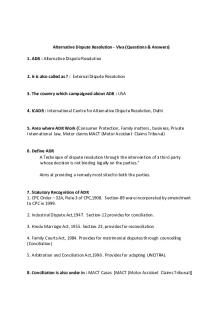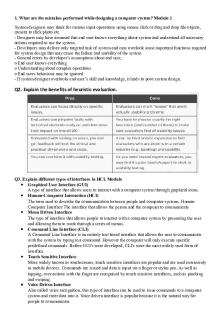CC LAB VIVA Questions - LAB viva study guide PDF

| Title | CC LAB VIVA Questions - LAB viva study guide |
|---|---|
| Course | Cloud Computing Laboratory |
| Institution | PES University |
| Pages | 6 |
| File Size | 113.5 KB |
| File Type | |
| Total Downloads | 18 |
| Total Views | 354 |
Summary
CC LAB VIVA QUESTIONSKeep posting CC lab VIVA questions here. You’ll be blessed by section D. All the best!● Another doc (main campus)- docs.google/document/d/1YuSL8IPJYXr8sIKMK7AnoD_RbtEuDBFc Aa61N0jGysg/edit?usp=drivesdk1) vpc full form definition - virtual private cloud - contains a pool of share...
Description
CC LAB VIVA QUESTIONS Keep posting CC lab VIVA questions here. You’ll be blessed by section D. All the best! ● Another doc (main campus)https://docs.google.com/document/d/1YuSL8IPJYXr8sIKMK7AnoD_RbtEuDBFc Aa61N0jGysg/edit?usp=drivesdk 1) vpc full form definition - virtual private cloud - contains a pool of shared resources allocated within a public cloud env, providing a certain level of isolation btw diff organozations using the resources. CC Viva Questions 2) jenkins definition: Jenkins is an extensible, open source continuous integration server. It builds and tests your software continuously and monitors the execution and status of remote jobs, making it easier for team members and users to regularly obtain the latest stable code. 3) what is S3 - Simple Storage Service- object storage service 4) what is beanstalk - AWS Elastic Beanstalk is an easy-to-use service for deploying docker and scaling web applications and services developed with Java, . NET, PHP, Node. js, Python, Ruby, Go, and Docker on familiar servers such as Apache, Nginx, Passenger, and IIS. ha 5) What is CI/CD? Continuous Integration/ Continuous Delivery - a method frequently used to deliver apps to customers by introducing automation into the stages of app development 6) What is container - Containers allow you to package your application and its dependencies together into one succinct manifest that can be version controlled, allowing for easy replication of your application across developers on your team and machines in your cluster. Containers allow apps to be deployed reliably and migrate quickly btw various computing environments by packaging code, config settings and dependencies into a single object 7)What is docker - Docker is a software platform that allows you to build, test, and deploy applications quickly. Docker packages software into standardized units called
containers that have everything the software needs to run including libraries, system tools, code, and runtime. A Dockerfile is a text document that contains all the commands a user could call on the command line to assemble an image. Using docker build users can create an automated build that executes several command-line instructions in succession. This page describes the commands you can use in a Dockerfile .
8)emr definition - Elastic MapReduce - Amazon EMR is a cloud big data platform for processing vast amounts of data using open source tools such as Apache Spark, Apache Hive (Paas) 9)iam full form and definition - Identity and access management (IAM) is a framework of business processes, policies and technologies that facilitates the management of electronic or digital identities. ... IAM systems can be deployed on premises, provided by a third-party vendor through a cloud-based subscription model or deployed in a hybrid model. An Amazon Machine Image (AMI) provides the information required to launch an instance. You must specify an AMI when you launch an instance.
10)DDOS attack - Distributed Denial Of Service - Bring down a server by overloading it with requests 11) How to setup jenkins with docker - 12) what is sns - Simple Notification Service - Amazon Simple Notification Service (SNS) is a cloud service for coordinating the delivery of push messages from software applications to subscribing endpoints and clients. All messages published to Amazon SNS are warehoused across several availability zones to prevent loss. 13) what is rabbitmq - RabbitMQ is a messaging broker - an intermediary for messaging. It gives your applications a common platform to send and receive messages, and your messages a safe place to live until received. 14) what is devops - Development And operations - DevOps (a portmanteau of “development” and “operations”) is the combination of practices and tools designed to increase an organization's ability to deliver applications and services faster than traditional software development processes.
15) what is kubernetes - Container Orchestration - Kubernetes, also known as K8s, is an open-source system for automating deployment, scaling, and management of containerized applications. It’s container management responsibilities include container deployment, scaling & descaling of containers & container load balancing.It lets you manage complex application deployments quickly in a predictable and reliable manner
16) explain working of vpc A virtual private cloud (VPC) is a virtual network dedicated to your AWS account. It is logically isolated from other virtual networks in the AWS Cloud. You can launch your AWS resources, such as Amazon EC2 instances, into your VPC. You can specify an IP address range for the VPC, add subnets, associate security groups, and configure route tables. A subnet is a range of IP addresses in your VPC. You can launch AWS resources into a specified subnet. Use a public subnet for resources that must be connected to the internet, and a private subnet for resources that won't be connected to the internet . To protect the AWS resources in each subnet, you can use multiple layers of security, including security groups and network access control lists (ACL). You can optionally associate an IPv6 CIDR block with your VPC, and assign IPv6 addresses to the instances in your VPC. 17) How do you connect to a cloud server? 1. Using cloud console through Web Browser 2. CLI with SDK provided by the Cloud service Provider 3. Using a REST API 18) Simple Query Service - SQS is a managed message queue service offered by Amazon Web Services (AWS). It provides an HTTP API over which applications can submit items into and read items out of a queue. The queue itself is fully managed by AWS, which makes SQS an easy solution for passing messages between different parts of software systems that run in the cloud.
19) Elements of VPC The following are the key concepts for VPCs: ●
Virtual private cloud (VPC) — A virtual network dedicated to your AWS account.
●
Subnet — A range of IP addresses in your VPC.
●
Route table — A set of rules, called routes, that are used to determine where network traffic is directed.
●
Internet gateway — A gateway that you attach to your VPC to enable communication between resources in your VPC and the internet.
●
VPC endpoint — Enables you to privately connect your VPC to supported AWS services and VPC endpoint services powered by PrivateLink without requiring an internet gateway, NAT device, VPN connection, or AWS Direct Connect connection. Instances in your VPC do not require public IP addresses to communicate with resources in the service.
●
●
Traffic between your VPC and the other service does not leave the Amazon network.
20) What is Hybrid cloud? Hybrid cloud is a solution that combines a private cloud with one or more public cloud services, with proprietary software enabling communication between each distinct service. A hybrid cloud strategy provides businesses with greater flexibility by moving workloads between cloud solutions as needs and costs fluctuate.
21) How are devOps and kubernetes connected? ● ● ● ●
It reduces workload and resolves contradictions between several environments. It enables developers to respond to customer requirements while depending on the cloud for a load of functioning applications. helps simplify container tasks, including rolling updates, canary deployment, and horizontal auto-scaling. it can streamline building, testing, and deploying pipelines
22) How to send a request to s3? REST APIs or AWS SDK
23) What is S3 and object size limit Individual Amazon S3 objects can range in size from a minimum of 0 bytes to a maximum of 5 terabytes.
24) What is Elastic IP? An Elastic IP address is a reserved public IP address that you can assign to any EC2 instance in a particular region, until you choose to release it.
25) What is Dockerfile A Dockerfile is a text document that contains all the commands a user could call on the command line to assemble an image. Using docker build users can create an automated build that executes several command-line instructions in succession. This page describes the commands you can use in a Dockerfile . 26) What is the difference b/w stopping and terminating an EC2 instance? The key difference between stopping and terminating an instance is that the attached bootable EBS volume will not be deleted. The data on your EBS volume will remain after stopping while all information on the local (ephemeral) hard drive will be lost as usual. ... Standard charges for EBS volumes will apply.
27) How can you connect to the cloud? 1. With Virtual Private Network or VPN, your computer accesses a server through the internet, using an encrypted connection. ... 2. The second way to connect in cloud computing is through a Remote Desktop Server or RDS. ... 3. The final way to connect to cloud computing is through Virtual Desktop Infrastructure or VDI.
28) curl is a command line tool to transfer data to or from a server, using any of the supported protocols (HTTP, FTP, IMAP, POP3, SCP, SFTP, SMTP, TFTP, TELNET, LDAP or FILE). 29) what's the maximum number of instances for vpc?
15000
30) how to connect to s3? To connect to your S3 buckets from your EC2 instances, you need to do the following: 1.Create an AWS Identity and Access Management (IAM) profile role that grants access to Amazon S3. 2. Attach the IAM instance profile to the instance. 3.Validate permissions on your S3 bucket. 4. Validate network connectivity from the EC2 instance to Amazon S3.
31) Plugins examples: withAWS awsIdentity cfInvalidate s3Upload s3 Download s3Copy s3Delete s3DoesObjectExist s3FindFiles s3PresignURL 32) ACL An access control list (ACL) is a mechanism you can use to define who has access to your buckets and objects, as well as what level of access they have. In Cloud Storage, you apply ACLs to individual buckets and objects. Each ACL consists of one or more entries....
Similar Free PDFs

DBMS Lab Viva Questions
- 7 Pages

Viva questions
- 6 Pages

Viva ADA QUESTIONS
- 12 Pages

ADR Viva QS - ADR VIVA
- 7 Pages

3YDC-Viva Questions PEPA
- 13 Pages

CCL viva questions
- 18 Pages

BEE VIVA QUESTIONS
- 8 Pages

Physics Viva Questions
- 16 Pages

Computer Network Viva questions
- 9 Pages

Instrumental viva questions
- 6 Pages

Physics Viva Questions-convertedpdf
- 16 Pages

HMI VIVA - HMI Viva Peparation
- 9 Pages
Popular Institutions
- Tinajero National High School - Annex
- Politeknik Caltex Riau
- Yokohama City University
- SGT University
- University of Al-Qadisiyah
- Divine Word College of Vigan
- Techniek College Rotterdam
- Universidade de Santiago
- Universiti Teknologi MARA Cawangan Johor Kampus Pasir Gudang
- Poltekkes Kemenkes Yogyakarta
- Baguio City National High School
- Colegio san marcos
- preparatoria uno
- Centro de Bachillerato Tecnológico Industrial y de Servicios No. 107
- Dalian Maritime University
- Quang Trung Secondary School
- Colegio Tecnológico en Informática
- Corporación Regional de Educación Superior
- Grupo CEDVA
- Dar Al Uloom University
- Centro de Estudios Preuniversitarios de la Universidad Nacional de Ingeniería
- 上智大学
- Aakash International School, Nuna Majara
- San Felipe Neri Catholic School
- Kang Chiao International School - New Taipei City
- Misamis Occidental National High School
- Institución Educativa Escuela Normal Juan Ladrilleros
- Kolehiyo ng Pantukan
- Batanes State College
- Instituto Continental
- Sekolah Menengah Kejuruan Kesehatan Kaltara (Tarakan)
- Colegio de La Inmaculada Concepcion - Cebu



